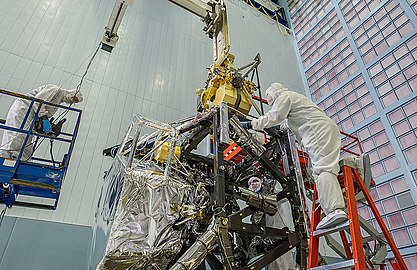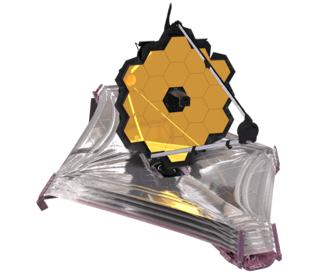
The James Webb Space Telescope (JWST) is a space telescope specifically designed to conduct infrared astronomy. Its high-resolution and high-sensitivity instruments allow it to view objects too old, distant, or faint for the Hubble Space Telescope. This enables investigations across many fields of astronomy and cosmology, such as observation of the first stars and the formation of the first galaxies, and detailed atmospheric characterization of potentially habitable exoplanets.

STS-82 was the 22nd flight of the Space Shuttle Discovery and the 82nd mission of the Space Shuttle program. It was NASA's second mission to service the Hubble Space Telescope, during which Discovery's crew repaired and upgraded the telescope's scientific instruments, increasing its research capabilities. Discovery launched from Kennedy Space Center, Florida, on February 11, 1997, returning to Earth on February 21, 1997, at Kennedy Space Center.
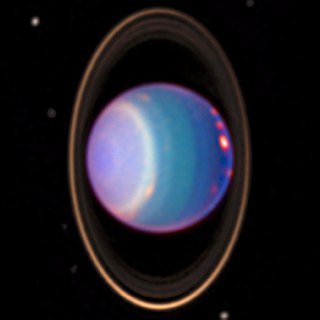
The Near Infrared Camera and Multi-Object Spectrometer (NICMOS) is a scientific instrument for infrared astronomy, installed on the Hubble Space Telescope (HST), operating from 1997 to 1999, and from 2002 to 2008. Images produced by NICMOS contain data from the near-infrared part of the light spectrum.
A grism is a combination of a prism and grating arranged so that light at a chosen central wavelength passes straight through. The advantage of this arrangement is that one and the same camera can be used both for imaging and spectroscopy without having to be moved. Grisms are inserted into a camera beam that is already collimated. They then create a dispersed spectrum centered on the object's location in the camera's field of view.

Donald F. Figer is an American astronomer and a professor in the College of Science of the Rochester Institute of Technology. He is also the director of RIT's Future Photon Initiative, Center for Detectors, and Rochester Imaging Detector Laboratory. His research interests include massive stars, massive star clusters, red supergiants, the Galactic Center, and the development of advanced technologies for astrophysics and a broad range of applications.

The Wide Field Camera 3 (WFC3) is the Hubble Space Telescope's last and most technologically advanced instrument to take images in the visible spectrum. It was installed as a replacement for the Wide Field and Planetary Camera 2 during the first spacewalk of Space Shuttle mission STS-125 on May 14, 2009.
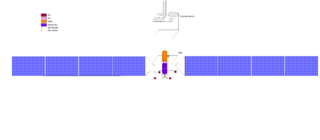
A satellite bus is the main body and structural component of a satellite or spacecraft, in which the payload and all scientific instruments are held.
LIDAX is a space technology company, founded at the beginning of the year 2000. It designs and manufactures advanced mechanical equipments that form part of complex space flight systems and instruments for Earth observation, planetary exploration (Exomars), astrophysics instrumentation and telecom. The activities of the company encompass all aspects, from conceptual design, through integration and testing up to realization; both for satellite and on-ground instrumentation.

The NIRSpec is one of the four scientific instruments flown on the James Webb Space Telescope (JWST). The JWST is the follow-on mission to the Hubble Space Telescope (HST) and is developed to receive more information about the origins of the universe by observing infrared light from the first stars and galaxies. In comparison to HST, its instruments will allow looking further back in time and will study the so-called Dark Ages during which the universe was opaque, about 150 to 800 million years after the Big Bang.

The James Webb Space Telescope (JWST) is an international 21st-century space observatory that was launched on 25 December 2021. It is intended to be the premier observatory of the 2020s, combining the largest mirror yet on a near-infrared space telescope with a suite of technologically advanced instruments from around the world.
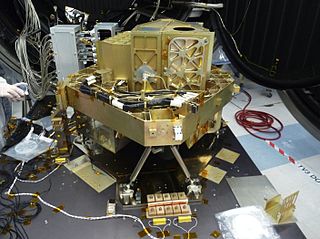
Fine Guidance Sensor and Near Infrared Imager and Slitless Spectrograph (FGS-NIRISS) is an instrument on the James Webb Space Telescope (JWST) that combines a Fine Guidance Sensor and a science instrument, a near-infrared imager and a spectrograph. The FGS/NIRISS was designed by the Canadian Space Agency (CSA) and built by Honeywell as part of an international project to build a large infrared space telescope with the National Aeronautics and Space Administration (NASA) and the European Space Agency (ESA). FGS-NIRISS observes light from the wavelengths of 0.8 to 5.0 microns. The instrument has four different observing modes.

Optical Telescope Element (OTE) is a sub-section of the James Webb Space Telescope, a large infrared space telescope launched on 25 December 2021, consisting of its main mirror, secondary mirrors, the framework and controls to support the mirrors, and various thermal and other systems.

NIRCam is an instrument aboard the James Webb Space Telescope. It has two major tasks, as an imager from 0.6 to 5 micron wavelength, and as a wavefront sensor to keep the 18-section mirrors functioning as one. In other words, it is a camera and is also used to provide information to align the 18 segments of the primary mirror. It is an infrared camera with ten mercury-cadmium-telluride (HgCdTe) detector arrays, and each array has an array of 2048×2048 pixels. The camera has a field of view of 2.2×2.2 arc minutes with an angular resolution of 0.07 arcsec at 2 microns. NIRCam is also equipped with coronagraphs, which helps to collect data on exoplanets near stars. It helps with imaging anything next to a much brighter object, because the coronagraph blocks that light.

MIRI, or the Mid-Infrared Instrument, is an instrument on the James Webb Space Telescope. MIRI is a camera and a spectrograph that observes mid to long infrared radiation from 5 to 28 microns. It also has coronagraphs, especially for observing exoplanets. Whereas most of the other instruments on Webb can see from the start of near infrared, or even as short as orange visible light, MIRI can see longer wavelength light.

The James Webb Space Telescope (JWST) sunshield is a passive thermal control system deployed post-launch to shield the telescope and instrumentation from the light and heat of the Sun, Earth, and Moon. By keeping the telescope and instruments in permanent shadow, it allows them to cool to their design temperature of 40 kelvins. Its intricate deployment was successfully completed on January 4, 2022, ten days after launch, when it was more than 0.8 million kilometers (500,000 mi) away from Earth.

The spacecraft bus is a carbon fibre box that houses systems of the telescope and so is the primary support element of the James Webb Space Telescope, launched on 25 December 2021. It hosts a multitude of computing, communication, propulsion, and structural components. The other three elements of the JWST are the Optical Telescope Element (OTE), the Integrated Science Instrument Module (ISIM) and the sunshield. Region 3 of ISIM is also inside the spacecraft bus. Region 3 includes the ISIM Command and Data Handling subsystem and the Mid-Infrared Instrument (MIRI) cryocooler.

The Infrared Array Camera (IRAC) was an infrared camera system on the Spitzer Space Telescope which operated in the mid-infrared spectrum. It was composed of four detectors that operated simultaneously at different wavelengths; all four were in use until 2009 May 15 when the Spitzer cryostat ran out of liquid helium. After then, the spacecraft operated in a warm extended mission, in which two of the four detectors remained functional, until the Spitzer mission was terminated on 2020 January 30.

The OTE Pathfinder, or James Webb Space Telescope Pathfinder, is a technology demonstrator and test article for the James Webb Space Telescope. It is a non-flight replica of the actual backplane, but only includes the center section, not the two "wings" on the side that extend and have additional segments on the actual JWST. It has been used for various tests and has some different configurations, but some of the major tests have been practicing installing mirror segments with non-flight hardware as well as thermal tests. The Pathfinder has also been tested in conjunction with flight hardware including the Aft Optics System. One of the goals and uses of the pathfinder is risk reduction for JWST program. The pathfinder allows practicing integration and testing procedures, and for risk mitigation With the Pathfinder it was possible to test phasing two mirrors together and also to do tests with the Aft Optical System. The OTE Pathfinder was part of the plan for integration and testing of JWST, and in particular supported the Optical Telescope Element.

Webb's First Deep Field is the first operational image taken by the James Webb Space Telescope (JWST). The deep-field photograph, which covers a tiny area of sky visible from the Southern Hemisphere, is centered on SMACS 0723, a galaxy cluster in the constellation of Volans. Thousands of galaxies are visible in the image, some as old as 13 billion years. The image is the highest-resolution image of the early universe ever taken. Captured by the telescope's Near-Infrared Camera (NIRCam), the image was revealed to the public by NASA on 11 July 2022.
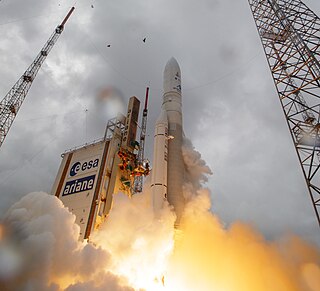
The James Webb Space Telescope (JWST) is a space telescope designed primarily to conduct infrared astronomy. Its complex launch and commissioning process lasted from late 2021 until mid-2022.




